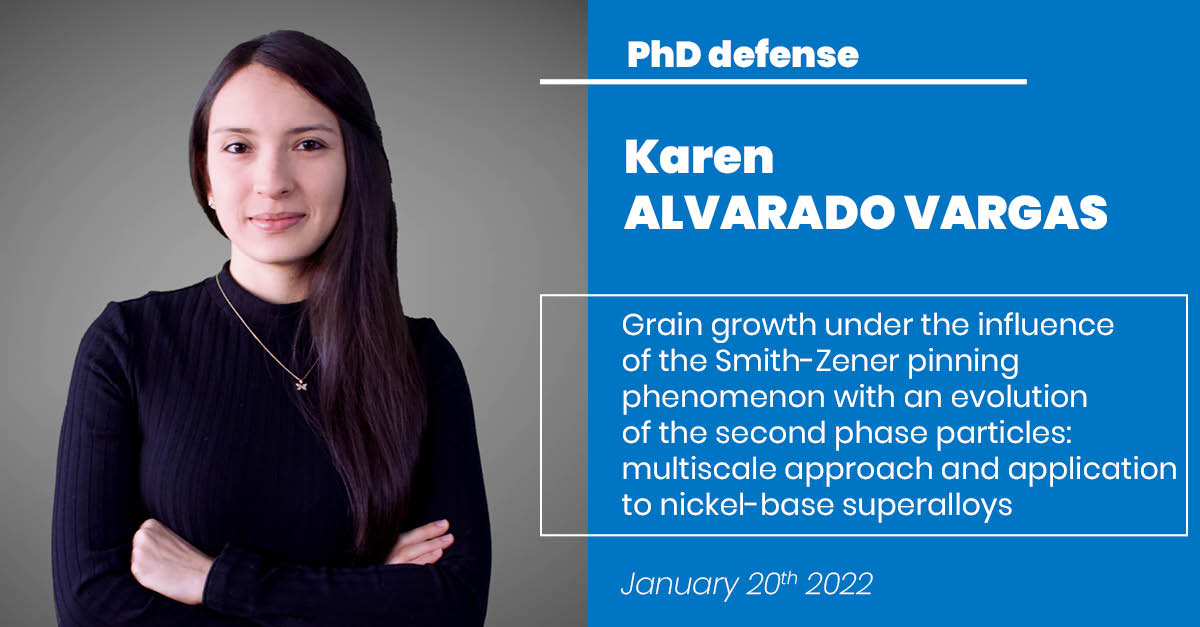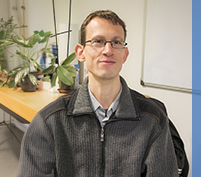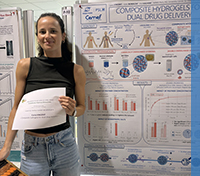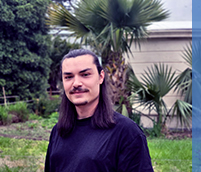PhD defence of Karen Alvarado Vargas
12 January 2022
Karen Alvarado Vargas defends her PhD in Computational Mechanics and Materials on Jan. 20th, 22
Grain growth under the influence of the Smith-Zener pinning phenomenon with an evolution of the second phase particles: multiscale approach and application to nickel-base superalloys

Karen Alvarado Vargas conducted her PhD work in MSR team, under the supervision of Marc Bernacki and Nathalie Bozzolo. Karen defends her PhD in Computational Mechanics and Materials on Jan. 20th, 2022 in front of the following jury:
– Prof. Julien Bruchon, Ecole des Mines de Saint Etienne, SMS
– Prof. Michel Perez, INSA Lyon
– Prof. Alain Hazotte, Université de Lorraine, LEM3
– Prof. Olga Bylya, University of Strathclyde, Advanced Forming Research Centre
– Dr. Pascal De Micheli, Transvalor
Abstract:
In most polycrystalline nickel base superalloys, the grain size is controlled by second phase particles which pin the grain boundaries. The Smith-Zener model describes this physical interaction. Industrial forging processes involve hot deformation steps near the solvus temperature, where second phase particle dissolution occurs. Therefore, it is essential to understand and predict their evolution to properly control the grain size obtained after a specific subsolvus solution treatment and, in turn, the related material properties.
Three nickel base superalloys were studied (AD730, René 65, N19) through a series of isothermal treatments and detailed microstructural analyses based on SEM and EBSD techniques. More precisely, the primary 𝛾’ precipitates, particle fraction, size, morphology as well as the grain size evolution were analyzed. A temperature-time codependency equation was established to describe the evolution of primary 𝛾’ precipitates of each material using experimental data, the Thermo-Calc results, and the Johnson-Mehl-Avrami-Kolmogorov (JMAK) model.
Numerical simulations could then be performed using a full-field modeling framework for simulating grain growth (GG) phenomena, based on the Level Set (LS) method within a finite element context, with second phase particle evolving according to the previously established kinetic models. This numerical approach was preferred over the others found in the literature because it can consider substantial deformations, which opens the possibility of reproducing more realistic thermomechanical paths like the ones used in the metal forming industry, including both hot deformation and thermal treatment steps. In this work, a new formalism based on the LS to model GG mechanisms under the influence of the Smith-Zener pinning and able to consider precipitate evolution was proposed. The precipitates are represented using an additional LS function; a numerical treatment around the grain boundary in the vicinity of the precipitates is then applied to reproduce their pinning pressure correctly. Thus, considering the actual precipitate dissolution based on phenomenological laws, these simulations aim to predict grain size evolutions not only in terms of long term steady state, but also within the transient regime.
Keywords: Grain growth, Smith-Zener pinning, Level-Set, full-field simulations, 𝛾-𝛾’ superalloys, precipitate dissolution kinetics








